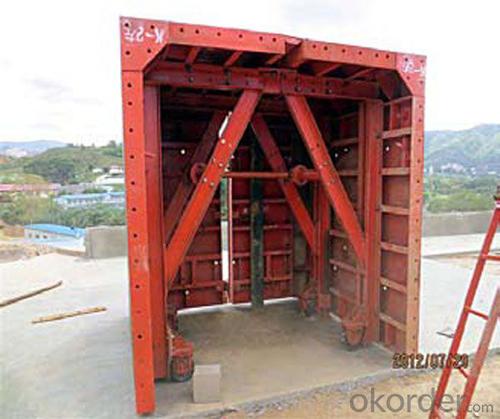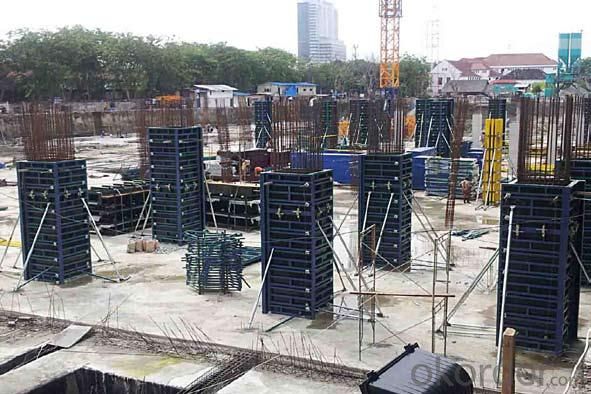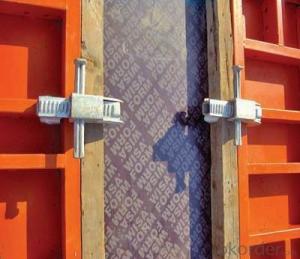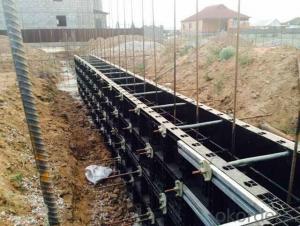Steel Formwork System Fromwork Accessories Good Prices
- Loading Port:
- Tianjin
- Payment Terms:
- TT OR LC
- Min Order Qty:
- 30 m.t
- Supply Capability:
- 1000 m.t/month
OKorder Service Pledge
OKorder Financial Service
You Might Also Like
Steel Formwork System Fromwork Accessories Good Prices
Product pictures:


Product description:
Name: | RingLock Scaffold System |
Category: | Scaffolding System |
Material: | Steel (Q235/Q345) |
Size: | D48*3.25mm, etc |
Surface: | Electro Galvanized, Hot Dipped Galvanized, Painted, Powder Coated |
Component: | Standard, Ledger, Diagonal Brace, Bracket, Base Jack, U Head Jack, Etc. |
Application: | Slab Support, Staircase, Stage Plateforms, Bridge Support, Mobile Tower, etc. |
Manufacturer: | OEM is Available |
Items or goods can be manufactured according to your standards. | |
Advantage
* Good loading capacity
* Easy to assemble and dismantle
* Excellent quality for formwork & scaffolding with wide choices
Other scaffolding & formwork products:
(1) Scaffolding System:
(2) Scaffolding Frame & Accessories:
(3) Scaffolding Couplers/Clamps:
(4) Formwork System Scaffolding & Accessories:
Company introduce and advantages:
1. A state-owned company, prestige fi rst.
2. One of Fortune 500 companies in the world. No. 5 in the building material fi eld.
3. Six Sigma strategy , which means no more than 3.4 defects existing among one million of error
possibilities.
4. In line with the business, we launched E-business platform Okorder.com.
5. We are highly recognized by our business partners and clients all over the world and has obtained rapid
development under the spirit of win-win.
FAQ
Why Us?
We are one of the largest construction materials suppliers in China.
We own professional manufacturers with powerful producing capacity.
Extensive and comprehensive quality control system
Excellent products with competitive prices.
Efficient services in pre and after sale.
Full energy with affluent experience team.
- Q: How does steel frame formwork ensure proper alignment and positioning of concrete structures?
- The strong and rigid construction of steel frame formwork guarantees the correct alignment and positioning of concrete structures. By assembling the formwork in a precise manner, accurate measurements can be achieved. The frames, which are typically pre-fabricated, can be easily adjusted and aligned to meet the required dimensions of the structure. This guarantees that the concrete will be poured and set in the correct position, preventing any misalignment or deviations from the intended design. Moreover, the flat and even surface of the steel frame formwork ensures that the concrete will be evenly distributed and will not settle in any specific area. This is crucial in maintaining the overall integrity and strength of the structure, while also preventing potential issues that may arise from uneven pouring. Furthermore, the steel frame formwork provides a stable and secure support system for the concrete. The frames are reinforced with bracing and tie rods, which hold everything in place during the pouring and curing process. This prevents any shifting or movement of the concrete, ensuring that it sets and cures in the desired position. In conclusion, the proper alignment and positioning of concrete structures are guaranteed by the strong and rigid construction of steel frame formwork. Accurate measurements, a level surface, and a stable support system all contribute to the successful construction of well-built concrete structures.
- Q: How does steel frame formwork reduce the risk of concrete leakage or seepage?
- Steel frame formwork reduces the risk of concrete leakage or seepage by providing a strong and stable framework that holds the concrete in place during the pouring and curing process. This prevents the concrete from shifting or leaking out of the desired area, ensuring a tighter and more secure seal. Additionally, the steel frame formwork is typically lined with waterproof materials, further minimizing the chances of water infiltration or leakage.
- Q: Can steel frame formwork be used in projects with limited access to utilities and services?
- Yes, steel frame formwork can be used in projects with limited access to utilities and services. Steel frame formwork is a versatile and durable construction solution that can be easily transported and assembled on-site. Unlike traditional formwork systems, steel frame formwork does not rely on utilities or services for its functionality. Steel frame formwork is designed to be self-supporting and does not require any external power or water supply. This makes it suitable for use in remote or inaccessible areas where utilities and services may be limited or non-existent. Additionally, the steel frame formwork system can be easily dismantled and reassembled, allowing for efficient use in multiple project locations with limited access to utilities and services. Furthermore, steel frame formwork offers several advantages such as high load-bearing capacity, excellent stability, and the ability to accommodate various architectural designs and complex shapes. It is also highly resistant to weather conditions and can withstand harsh environments, making it a reliable choice for projects in remote or challenging locations. In conclusion, steel frame formwork can be effectively utilized in projects with limited access to utilities and services. Its portability, versatility, and self-supporting nature make it a practical construction solution that can overcome the challenges posed by limited utilities and services in remote or inaccessible areas.
- Q: Can steel frame formwork be reused multiple times?
- Yes, steel frame formwork can be reused multiple times. Steel is a durable and strong material that can withstand multiple uses without compromising its structural integrity. This makes it cost-effective and efficient for construction projects where formwork needs to be repeatedly used. Additionally, steel frame formwork can be easily demounted and reassembled, further facilitating its reuse.
- Q: Can steel frame formwork be used for both above-ground and below-ground concrete elements?
- Yes, steel frame formwork can be used for both above-ground and below-ground concrete elements. Steel frame formwork is versatile and can be easily customized to suit various project requirements. Its durability and strength make it suitable for both above-ground structures like beams, columns, and slabs, as well as below-ground elements like basements, foundation walls, and retaining walls.
- Q: Can steel frame formwork be used for retrofitting or renovation projects?
- Yes, steel frame formwork can be used for retrofitting or renovation projects. Steel frame formwork is a versatile and durable system that is commonly used in construction projects, including retrofitting and renovation projects. It is designed to provide support and structure to concrete during the pouring and curing process. In retrofitting or renovation projects, steel frame formwork can be used to create new concrete structures or to repair and strengthen existing structures. It can be used to create new walls, beams, columns, or slabs, or to reinforce existing ones. The advantage of using steel frame formwork in retrofitting projects is that it provides a strong and stable support system, ensuring that the concrete is poured and cured correctly. It can also be easily adjusted and repositioned as needed, allowing for flexibility in design and construction. Additionally, steel frame formwork is reusable, which makes it cost-effective and environmentally friendly. It can be easily dismantled and reused in multiple projects, reducing waste and saving resources. Overall, steel frame formwork is a suitable and efficient solution for retrofitting or renovation projects, providing the necessary support and structure for concrete elements while offering flexibility, durability, and cost-effectiveness.
- Q: How does steel frame formwork handle concrete pouring in windy conditions?
- Steel frame formwork is designed to withstand windy conditions during concrete pouring. The solid and sturdy structure of steel frame formwork provides stability and strength, which minimizes the impact of strong winds on the concrete pouring process. Steel frame formwork is constructed with durable steel frames that are securely anchored to the ground. This anchoring system ensures that the formwork remains in place even in high winds, preventing any displacement or movement that could compromise the integrity of the concrete structure. Additionally, the steel frame formwork is often reinforced with diagonal bracings or tie rods to further enhance its stability. In windy conditions, the steel frame formwork acts as a barrier, shielding the concrete from direct exposure to the wind. This helps in maintaining the desired consistency and quality of the concrete during pouring. The solid construction of the formwork also prevents any unwanted deformations or distortions caused by wind pressure. To further mitigate the effects of wind, additional precautions can be taken during the concrete pouring process. For instance, pouring concrete in windy conditions can be done in smaller sections to minimize the exposure time and reduce the risk of wind-induced complications. Moreover, using windbreakers or wind barriers around the construction site can provide additional protection from gusts of wind. Overall, steel frame formwork is designed to handle concrete pouring in windy conditions by providing a stable and secure structure that protects the concrete and ensures the successful completion of the construction project.
- Q: How does steel frame formwork compare to other types of formwork in terms of durability?
- Steel frame formwork is highly regarded for its exceptional durability compared to other types of formwork. Its sturdy construction, made from high-quality steel, provides excellent resistance to wear and tear, making it ideal for repeated use in construction projects. Unlike other formwork materials like wood or plastic, steel frame formwork is less prone to deformation, warping, or breaking under pressure or adverse environmental conditions. This enhanced durability ensures that steel frame formwork can withstand the demands of heavy concrete pouring and remains structurally intact throughout the entire construction process, resulting in increased efficiency and cost-effectiveness.
- Q: Can steel frame formwork be used in underground construction projects?
- Indeed, underground construction projects can make use of steel frame formwork. Steel frame formwork is a system that is both versatile and durable, making it a popular choice for a variety of construction applications, including underground projects. Its strength and rigidity enable it to withstand the pressures and forces commonly associated with underground construction. Typically constructed from high-quality steel, steel frame formwork offers excellent structural integrity and resistance to deformation. This quality makes it particularly well-suited for use in underground projects, where the soil and surrounding environment can exert increased levels of pressure. Furthermore, steel frame formwork provides flexibility in design and can be easily customized to meet the specific requirements of underground construction projects. Its adaptability allows for the creation of intricate shapes and structures, which are often necessary in underground constructions such as tunnels, subway systems, and basements. Another advantage of steel frame formwork is its reusability, which can lead to cost savings and reduced environmental impact in underground construction. The formwork can be effortlessly dismantled, relocated, and reassembled in different locations, making it an economical choice for projects that involve multiple construction phases. In conclusion, steel frame formwork is an ideal option for underground construction projects due to its strength, durability, flexibility, and reusability. It provides the necessary structural support and adaptability required to tackle the unique challenges associated with underground construction, making it a preferred choice for many engineers and contractors.
- Q: How does steel frame formwork prevent the formation of concrete shrinkage cracks?
- Steel frame formwork prevents the formation of concrete shrinkage cracks by providing strong and rigid support to the concrete during the curing process. It ensures that the concrete remains in its desired shape and position, preventing any movement or displacement that could lead to crack formation. Additionally, the steel frame formwork helps in evenly distributing the forces and stresses exerted by the curing concrete, minimizing the potential for shrinkage cracks to develop.
Send your message to us
Steel Formwork System Fromwork Accessories Good Prices
- Loading Port:
- Tianjin
- Payment Terms:
- TT OR LC
- Min Order Qty:
- 30 m.t
- Supply Capability:
- 1000 m.t/month
OKorder Service Pledge
OKorder Financial Service
Similar products
Hot products
Hot Searches
Related keywords























